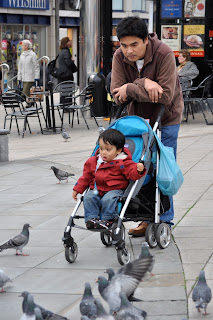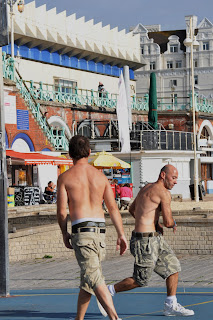Studying cinema history (or history of film) last year gave me the opportunity to read more authors who wrote about photography, such as Susan Sontag, Rosalind Krauss, Roland Barthes and Walter Benjamin. Before those days I'd only looked at my favourite and very different photographers, such as Avedon, Leibovitz, Beaton, Nan Goldin, Francesca Woodman, Jeanloup Sieff, Irving Penn, Peter H. Fürst, Hoyningen-Huené, Horst P. Horst, Charlotte March, Walde Huth, Atget, Cartier-Bresson… Later I discovered I also love the work of William Klein, who I didn’t know a month ago.
For my project I was trying to think in which things people spend their time on, what people do in Brighton in autumn (as the season it was). Later I would also discover something that linked to my first idea. It was not the opposite, but the consequences of the different 'ways of living'. These consequences were my "costs" of living. So I noticed I could manage to capture not the time because of its impossibility, but what people normally do when waiting - not losing their time, just waiting. Most of times I didn't know what or who they were waiting for, although in other ones I could see it.
That's why I focused on many underground stations in London, as South Kensington, or many crowded places, as Piccadilly Circus. It wasn't only the time people spend waiting what I wanted to show: also, the different ways of waiting. I found, in one hand, people that become engrossed in one's thoughts and, in the other one, people that are connected to their world (with mobile phones, etc.). I preferred the first group with no doubt. It was difficult to take the photos in such crowded places just because another fact of time and people waiting -now the opposite- was the speed, the movement of lots, and lots, and lots of people.
I have to say that, from my experience as if I were them (trying to live my victim's role), I've always hated people walking or running in a hurry (group 1, people I didn't take photos of), although I knew when I'm alone I really like to walk faster and don't notice it. Moreover, I've always been (and I am, indeed) the kind of person who is really late every time I'm meeting someone, so when I was in this situation I walked or ran as they were doing for achieving to arrive earlier (less later). So, how could I have imagined the special way of every person to wait? (group 2, people I've taken photos of). And among all of them there were people working (group 3, photographed too), also waiting a few minutes when they had no other people to whom give in newspapers or small papers with advertisements.
The resulting photos of my project show people who live constantly in anxiety and nervously, people who wait faithfully, and people who have no time to waste and wait exactly 10 minutes and then go away. Those who I’ve liked the most are the people whose mind was in outer space and who were completely strong like a wall, strong in the sense that I could take the photo of them but never go through their thoughts, their feelings. They are the main protagonists of my project.
The resulting photos of my project show people who live constantly in anxiety and nervously, people who wait faithfully, and people who have no time to waste and wait exactly 10 minutes and then go away. Those who I’ve liked the most are the people whose mind was in outer space and who were completely strong like a wall, strong in the sense that I could take the photo of them but never go through their thoughts, their feelings. They are the main protagonists of my project.
So my worries were focused on the speed of nowadays (as the consequence of the time and people waiting). People don't enjoy time just because they cannot: they have no time, they're in a hurry, they've too much work to do. But they're still people with personal problems and lots of own and private thoughts and feelings (I defend there are people who haven't them). Probably this is one of the most common and problematic costs of living at the moment: time - no time.
































































